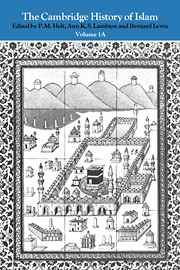Book contents
- Frontmatter
- Introduction
- Part I The rise and domination of the Arabs
- Part II The coming of the steppe peoples
- Part III The central Islamic lands in the Ottoman period
- 1 The rise of the Ottoman empire
- 2 The heyday and decline of the Ottoman empire
- 3 The later Ottoman empire in Rumelia and Anatolia
- 4 The later Ottoman empire in Egypt and the fertile crescent
- 5 Safavid Persia
- 6 Persia: the breakdown of society
- 7 Central Asia from the sixteenth century to the Russian conquests
- Appendix The Golden Horde and its successors
- 8 Tsarist Russia and the Muslims of central Asia
4 - The later Ottoman empire in Egypt and the fertile crescent
from Part III - The central Islamic lands in the Ottoman period
Published online by Cambridge University Press: 28 March 2008
- Frontmatter
- Introduction
- Part I The rise and domination of the Arabs
- Part II The coming of the steppe peoples
- Part III The central Islamic lands in the Ottoman period
- 1 The rise of the Ottoman empire
- 2 The heyday and decline of the Ottoman empire
- 3 The later Ottoman empire in Rumelia and Anatolia
- 4 The later Ottoman empire in Egypt and the fertile crescent
- 5 Safavid Persia
- 6 Persia: the breakdown of society
- 7 Central Asia from the sixteenth century to the Russian conquests
- Appendix The Golden Horde and its successors
- 8 Tsarist Russia and the Muslims of central Asia
Summary
The Ottoman decline in the eleventh/seventeenth century
The decline of the Ottoman state, which manifested itself in the eleventh/ late sixteenth–seventeenth centuries, affected the Arab provinces as well as the older dominions of Anatolia and Rumelia. Some territories were lost to the empire. Baghdād was reoccupied by the Safavids from 1033/1623 to 1048/1638, while in 1045/1635 the Ottomans abandoned their precarious tenure of the Yemen. Even where the form of the sultan's suzerainty was maintained, and the façade of the old provincial administration remained in being, locally based forces were striving for mastery in the provinces, and here and there local despotisms crystallized out of the general anarchy.
The drift to anarchy is well exemplified in the history of Egypt in the early eleventh/seventeenth century which, it may be noted, coincides with the great crisis of the Ottoman empire. A series of military risings against the viceroys (one of whom was murdered by mutinous troops in 1013/1605) culminated in a menacing revolt of the soldiery of the Delta in 1017/1609. The suppression of this revolt (which was described by a chronicler as ‘the second conquest of Egypt during the sacred Ottoman government’) did not permanently re-establish the viceregal power. By the middle of the century the beys, who were mostly members of neo-Mamluk households, had emerged as contenders for power with the viceroys and the officers of the garrison-corps.
- Type
- Chapter
- Information
- The Cambridge History of Islam , pp. 374 - 393Publisher: Cambridge University PressPrint publication year: 1977



